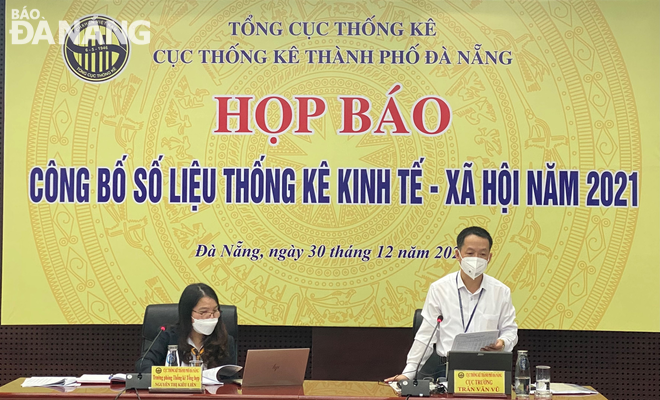Da Nang's GRDP rises by 0.18%
The growth rate of Da Nang’s gross regional domestic product (GRDP) in 2021 increased by 0.18% as compared to 2020. Of which, the service sector grew by 1.24 %, the agro-forestry-fishery sector saw a decline of 2.38%, the industry and construction sector decreased by 2.13% and the taxes less subsidies on production witnessed a drop of 1.44%.
 |
| Head of the Da Nang Statistics Bureau Tran Van Vu (right) announcing the city's socio-economic data in 2021. Photo: M.QUE |
The city’s average GRDP per capita at current price by late this year is estimated at VND87.87 million VND, equivalent to US$3,753.
The figures were released by the Da Nang Statistics Bureau at its Thursday press conference to announce the city's socio-economic development targets in 2021.
The scale of the city’s whole economy in 2021 is estimated at VND105,050 billion, an expansion of nearly VND1,826 billion against last year. The overall labour productivity of the whole economy (including product tax) at the current price is estimated at VND194.6 million/person/year, down 0.83% a year earlier.
As of December 20, 2021, the total State budget collection in Da Nang reached VND20,070 billion, representing 90.8% over the same period in 2020. In detail, domestic revenue was VND 15,742 billion, equivalent to 83.7% over the previous year while taxes on imports and exports was VND 4,057 billion, up 33.7% over the same period last year. The State budget expenditure dropped by 1.8% against 2020 to stand at VND26,844 billion.
As of December 15, 2021, the Da Nang government granted business registration certificates to a combined total of 3,542 new domestic and foreign businesses, branches and representative offices, with a total registered charter capital of VND17,781 billion.
The figures represented a drop of 13.8% and 17% in the number of newly-established firms and in the total registered investment capital, respectively when compared with the same period last year.
The total social development investment capital in 2021 is estimated at VND31,639 billion. Of which, the state capital sources reached an estimate of VND9,944 billion, up 11.04% and accounting for 31.4% of the total realized capital in the area, whilst the non-state capital sources was estimated at VND16,668 billion VND, down 9.4% and making up for 52.7% of the total capital. Realized capital of FDI projects deeply decreased by 31.1% and accounted for 15.9% of total realized capital in the year.
The total import-export turnover in 2021 climbed by 13.2% as compared to the same period last year to nearly US$3,183 million, in which, the export value hit US$ 1,835 million, up 16.9% whilst that of imports reached US$ 1,348 million, up 8.5%.
Thus, the goods trade balance registered a surplus of US$487 million for the whole year. The economic openness in terms of imports and exports was 70.9%.
Da Nang’s Consumer Price Index (CPI) in December increased by 2.26% as compared to the same period last year. CPIs over months of 2021 and the average CPI of the year was always below 4% in line with the inflation control target set by the National Assembly.
Head of the Da Nang Statistics Bureau Tran Van Vu remarked along with Ha Noi and Hai Phong, Da Nang recorded a positive socio-economic growth despite being severely affected by COVID-19.
Still encouragingly, an increase was reported in many industries. Specifically, the information and communication service sector increased by 10.47%, the finance, banking and insurance sectors by 7.84%, and the health care and social assistance sector by 23.85%. The manufacturing of rubber and plastic products rose by 37.9%, and electrical equipment production by 20.5%.
Mr. Vu also proposed a number of solutions to remove difficulties in socio-economic development in the coming time, with a focus on effectively implement policies about trade promotion, and support policies for businesses to build and develop their brand names.
Also, heed will be paid to restoring tourism activities in a new normal, as well as restructuring debt payment declines, and the exemption and reduction of taxes, interest rates and fees.
Importance will be attached to promoting investment attraction, accelerating the restructuring of agricultural production fields towards modernity and efficiency, and creating a transparent and open investment and business environment.
Reporting by M.QUE - Translating by M.DUNG